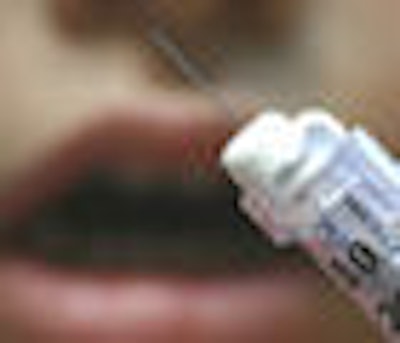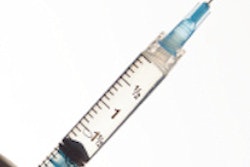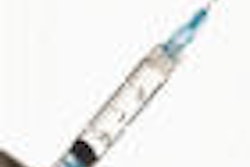
Will mandibular infiltration ever replace the inferior alveolar nerve block (IANB)? Researchers have been picking away at this question for years. An article published in this month's Journal of the American Dental Association brought them another step closer to the answer.
Articaine in a 4% solution with 1:100,000 epinephrine numbed mandibular first molars better than five other formulas of anesthetic in the study on buccal infiltration by University of Pittsburgh investigators (JADA, August 2009, Vol. 140:8, pp. 1018-1024). But none of the formulas provided reliable enough anesthesia to support the idea of using the infiltration in place of an IANB, at least with a half-cartridge dose, they noted.
"I don't think mandibular infiltration is a replacement for mandibular block, but I think more research needs to be done," said Sean Boynes, D.M.D., study co-author and an assistant anesthesiology professor at the University of Pittsburgh School of Dental Medicine.
IANB works well for numbing mandibular teeth, but also causes numbness in places it isn't wanted. In addition, it sometimes brings on trismus and paresthesia.
Buccal infiltration doesn't seem to cause these problems. And it's simpler to master than some of the other alternatives, such as intraosseous and intraligamentary injections. But infiltration doesn't work as well in the mandible as in the maxilla because of the mandible's thick cortical bone.
In a previous study (JADA, August 2007, Vol. 138:8, pp. 1104-1112), Ohio State University researchers were only able to achieve successful anesthesia in 57% of the patients with 2% lidocaine with 1:100,000 epinephrine in a buccal infiltration. (They defined "successful anesthesia" as twice failing to respond to an 80, the maximum output, of an electric pulp tester.)
But the advent of articaine in recent years has raised hopes that it might succeed where lidocaine has fallen short. The Ohio State researchers were able to achieve successful anesthesia in 87% of patients' mandibular first molars using 4% articaine with 1:100,000 epinephrine (a significant difference compared to lidocaine; p < 0.0001).
Why not prilocaine?
Other researchers have come up with a lower rate of successful anesthesia with an articaine infiltration (Journal of Endodontics, April 2006, Vol. 32:4, pp. 296-298). Others still have found that prilocaine might work just as well as articaine (Journal of the Canadian Dental Association, March 1991, Vol. 57:3, pp. 217-223).
So the Pittsburgh researchers decided to test articaine in an inferior nerve block against all the other local anesthetics commonly used in the U.S. They tested the following formulas:
- 2% lidocaine with 1:100,000 epinephrine
- 4% articaine with 1:200,000 epinephrine
- 4% articaine with 1:100,000 epinephrine
- 4% prilocaine with 1:200,000 epinephrine
- 3% mepivacaine without vasoconstrictor
- 0.5% bupivacaine with 1:200,000 epinephrine
The researchers injected each formula into the buccal fold adjacent to the distal root of the same mandibular first molar for each patient. They used only a half cartridge (0.9 mL) of each formula, partly because they only had 18 subjects and wanted to test each of the formulas in each patient without subjecting them to too much anesthetic.
"There is not a lot of space down there, and the tissue tends to bubble up," Dr. Boynes said. Researchers in the Ohio State study and several others have used full cartridges.
The Pittburgh researchers found that 38.9% of the subjects achieved full anesthesia with articaine 1:100,000 epinephrine, compared to only 16.7% of those who received lidocaine. The next-best results were with mepivacaine and articaine with 1:200,000 epinephrine; with both formulas, 33.3% of subjects achieved full anesthesia. The success rate was 22.2% for prilocaine and 11.1% bupivacaine. Though these differences showed a trend toward an advantage for articaine, the difference was not statistically significant (p = 0.29).
Stacking up the data in another way, the investigators compared the maximum electric pulp test output that the subjects could endure with no sensation. By this measure, they found that only 4% articaine with 1:100,000 epinephrine got patients to a statistically significant (p = 0.029) higher mean output than 2% lidocaine did.
"It does show that articaine is better in that regard than lidocaine," said John Yagiela, D.D.S., Ph.D., an anesthesiology professor and the chair of the division of diagnostic and surgical sciences at the University of California, Los Angeles School of Dentistry. Based on this study, the other anesthetic formulas "are out of the running for this specific purpose," he said.
But fully numbing only 38.9% of patients clearly isn't good enough for really painful procedures, Dr. Boynes said, so he recommends only considering infiltration as an alternative to IANB for relatively less invasive procedures such as treating surface caries and scaling and root planing on a quadrant or single tooth.
Al Reader, D.D.S., M.S., one of the Ohio State researchers, questioned whether mandibular infiltration is useful at this dose even for these procedures, since they can also be done without anesthesia or with only a topic anesthetic.
"The message to the dentist is that half of a cartridge isn't going to do anything," he said.
But infiltration with a full cartridge might prove useful for those patients who aren't numb after receiving an IANB, Dr. Reader noted.
He recommended the following approach: Do the IANB. Then test the tooth, either with ice or a pulp tester. If the tooth is numb, go ahead with the procedure. If it isn't, do the infiltration. "This is good stuff," he said.
Copyright © 2009 DrBicuspid.com



















